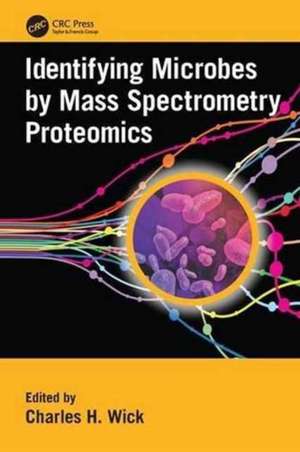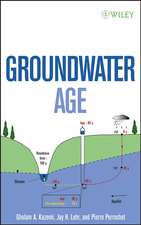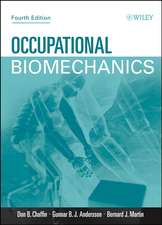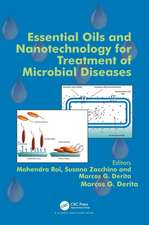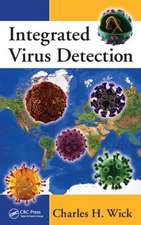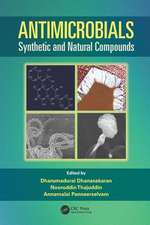Identifying Microbes by Mass Spectrometry Proteomics
Editat de Charles H. Wicken Limba Engleză Paperback – 16 noi 2016
This book reviews various mass analyzers used for detection and describes ionization methods frequently used for analysis of microbial constituents, a necessary step in the preparation of mass spectrometry (MS) samples. The text also discusses diverse processing methods, which are used to analyze MS files for matching mass spectral profiles, and examines protein and nucleic acid sequence-based methods capable of classification and identification of microbial agents. The book also covers sample collection methods and specific sample preparation techniques.
The text addresses using computer software and bioinformatics approaches for data mining to discriminate microbes using mass spectrometry proteomics (MSP). It also discusses historical pattern recognition-based methods and other approaches such as analysis of pyrolysis products, chemical ionization (CI) of fatty acid methyl esters, and MALDI-MS. The text contains examples of the application of the MSP technique for microbe detection and includes a survey of suitable and commercially available MS-based platforms. Successful applications include the identification of unknown microbes in honey bees associated with colony collapse disorder and the analysis of virus strains from the 2009 influenza pandemic. The final chapter outlines future trends in these groundbreaking uses of MS techniques, which are fast, not limited by sample type, and show potential in answering complex environmental questions.
| Toate formatele și edițiile | Preț | Express |
|---|---|---|
| Paperback (1) | 613.49 lei 6-8 săpt. | |
| CRC Press – 16 noi 2016 | 613.49 lei 6-8 săpt. | |
| Hardback (1) | 1333.33 lei 6-8 săpt. | |
| CRC Press – 10 sep 2013 | 1333.33 lei 6-8 săpt. |
Preț: 613.49 lei
Preț vechi: 721.76 lei
-15% Nou
Puncte Express: 920
Preț estimativ în valută:
117.41€ • 122.12$ • 96.93£
117.41€ • 122.12$ • 96.93£
Carte tipărită la comandă
Livrare economică 15-29 aprilie
Preluare comenzi: 021 569.72.76
Specificații
ISBN-13: 9781138199866
ISBN-10: 1138199869
Pagini: 289
Ilustrații: 98
Dimensiuni: 156 x 234 mm
Greutate: 0.45 kg
Ediția:1
Editura: CRC Press
Colecția CRC Press
Locul publicării:Boca Raton, United States
ISBN-10: 1138199869
Pagini: 289
Ilustrații: 98
Dimensiuni: 156 x 234 mm
Greutate: 0.45 kg
Ediția:1
Editura: CRC Press
Colecția CRC Press
Locul publicării:Boca Raton, United States
Cuprins
Detection and Identification of Microbes Using Mass Spectrometry Proteomics. Mass Analyzers and MS/MS Methods for Microbial Detection and Identification. Matching Mass Spectral Profiles of Biomarkers. Sequence Information Derived from Proteins or Nucleic Acids. Collection and Processing of Microbial Samples. Computer Software Used for Chemometric and Bioinformatics to Discriminate Microbes. Applications. Survey of Commercially Available MS-Based Platforms Suitable for Bacterial Detection and Identification. Current and Future Trends in Using MS for Microbial Detection and Identification. References. Index.
Notă biografică
Dr. Charles H. Wick, Ph.D., is a retired senior scientist from the U.S. Army Edgewood Chemical Biological Center, where he has served both as a manager and research physical scientist and has made significant contributions to forensic science. Although his 40-year professional career has spanned both the public sector and the military, his better-known work in the area of forensic science has occurred in concert with the Department of Defense. Throughout his career, Dr. Wick has made lasting and important contributions to forensic science and to the field of antiterrorism. He holds several U.S. patents in the area of microbe detection and classification. He has written more than 45 civilian and military publications and has received myriad awards and citations.
Descriere
This book is a comprehensive resource on using mass spectrometry proteomics (MSP), a powerful new technique combining hardware and software, as a highly accurate means for the detection, identification, and classification of microbes including unknown or unsequenced bacteria, viruses, and fungi. Chapters describe various mass analyzers, methods for analyzing MS data files, genomic approaches, sample collection and processing, software and bioinformatics, and examples of application of the method. This book also surveys commercially available MS-based platforms suitable for MSP and discusses future trends in these groundbreaking techniques.
